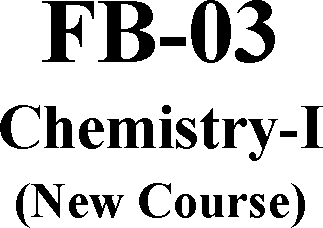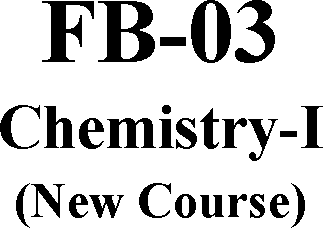Gujarat University 2005 B.Sc Chemistry First Year - Question Paper
FYBSC Chemistry-I.pdf
Seat No.

[Total Marks : 70
Time : 3 Hours]
l : (1) H-t Oil.
(2) -P.h p y.2"il .
(3) W3U HL>;H fcSltclCL Hi llM-ll t,2L p -SlR $
(4) GtR-mBlMHI UM'HLh OLMctl.
I. (H) A-tl >cllL Hltl.
(5)
(1) [Ms -. IlhL m'L.
(2) &*HL iCrLmH.-U [!i*ii [RH PWmIlhL [-A--, hPl.
(3) 350K rLLLLLi 2 itOL cLL|i PLHrlltLl VLrLl=lrtt HL -LrLL h- 200 *il.eCl -Ll 400 il.oll. H-t r-llP -AO. hl-l LSlL.
(R = 1.987 hciPl Ml -1 ilCL -1)
(H) S-tL WH Hltl (4)
(1) llC-LL 'i H-L HLctlhrLL HsO. ? HLHRll Hh Hlh itC-LL aWld.
(2) yB-LhWl HLPOih PLLrLL PLHL-t L-l (a = b) M terlUl 'H-il li[iL 35% il -LclL 12 iMa4 PLH-L CLL\ $. ilC-LL 65% tysl -LclL CLLOLrLl PLH-L Lli.
(h) -ii >clL-L Hltl (5)
(1) ciL-LiL HlcirH HcRlL-U [L-Li UP -iTl CL"il.
(2) ciL-L-iL y.qM'lhlHl [ctCcLfci tttUrlHVll CLiLrL Lll.
II. (H) l-LL Hltl. (10)
(1) HLrLP Hl-L-Llh Hlh'fel fettllri PLWicl.
(2) "tip-. >ot[ciH.i>'-l HaCl ?i ? [->W Haiti H-l tm .M trii "tl-LL cLl-L LclL ll CL [lH.l>H HUlh H-l pH Hl-. dRcil.
(3) HSP lcM HaCl ?i ? rll-Ll OLlLlhrllHL Wld. HSP [cLrllP. H-l HSP
"tHrll .Wld
(4) it- y.mcl - rLC-Lcllhrll, HcMhrll, CcL[$le ptHhrll.
1
(H) U3ll
(1) >L 0.001 N NaNO3 -LI LCMMidi 118 L-&.Ll.2 l-L Ll -LlL-Ll [cLLiL U2-ll 0.001 N HNO3 -Ll L1lcLL.irLL =H-i il>L L-ii ?lM.
= 2050 =HLH*l
|
0.001 N HCl |
.-L |
RHCl |
|
0.001 N NaNO3 |
.-L |
RNaNO- |
|
0.001 N NaCl |
.-L |
RNaCl |
3
= 2080
(2) n[lGLla.. 24 OiLH CH3COOH =H-i 1.64 OLLH CH3COONa tRL=lriL HS2 LcU3L pH LSlL. CH3COOH -ii Ka=1.80 x 10-5 $.
III. (=H) l-LL =HLUi..
(7)
(1) $>i-l, tei, ylil-iL m-tirR-LL Pm arnci\.
(2) is-sO.-. LCL-L (Nuclear Fusion) U2 -itL CL"ll.
(3) 8O16 H.a Wl-i foW =H-i Ai ILLLL LLl.
(O = 16.01470 Ro = 1.3 f)
(H) l-LL >rcii&i LUl.
(7)
(14)
(1) \ =H-i \\)2 -L -L-ta-l .Wic!.
(2) lEai-l [cltlii -L LOL-L .CH U2 -LlU CL"!
(3) iiM ClAl-L-Ll oHsclH ll-ll [-L-Lll-ll aiHi LLrll =HlUl.
IV. 9iei-LL >cill lLL.
(=H) cfti-UlclC'l-LL [&HlLd LHi. -M-ii Hl-LL =HLM3. .Wic!.
CLaty. $l&-l 4aCl $j. ? kf *ali Hta hVL-4&r -M =h-L amci\.
(H)
(i)
(i)
(E)
UHU3L (stoichiometric) Wlte-Ll-Ll "liMM ll.
U2 -iTl CL"il. sp3 =H-i sp3d Lii-Ll -Llo-L S-LL iAl .Wic!.

[Total Marks : 70
Time : 3 Hours]
Instructions : (1) Write short and precise answer.
(2) Each question carries equal marks.
(3) Figures on the right indicate full marks.
(4) Write correct number of question in answer book.
I. (a) Answer Two :
(5)
(1) Derive Kirchoffs equation.
(2) Give various statements of second law of thermodynamics.
(3) Volume increases from 200 ml. to 400 ml. when 2 moles of a gas expands isothermally and reversibly at 350K. Calculate work done in the process.
(R = 1.987 cal. degree-1mole-1)
(b) Answer One : (4)
(1) What is order of a reaction and molecularity ? Explain pseudo monomolecular reaction.
(2) A second order reaction with equal initial concentration of both reactants (a = b) is 35% completed in 12 minutes. Calculate time taken for 65% completion of this reaction.
(c) Answer One : (5)
(1) Write a note on the law of corresponding states of a gas.
(2) Discuss the principles of various methods of liquification of gases.
II. (a) Answer Two : (10)
(1) Explain inter ionic attraction theory.
(2) What is hydrolysis of salt? Derive an expression for hydrolysis constant and pH of an aqueous solution of a salt obtained from weak acid and strong base.
(3) What is buffer solution ? State its characteristics. Explain buffer range and buffer capacity.
(4) Explain the terms - Equivalent conductance, molar conductance and specific resistance.
(b) Calculate one :
(1) If equivalent conductance of 0.001 N NaNO3 is 118 mhos-cm2, calculate equivalent conductance of 0.001 N HNO3 and cell constant from the following data :
(4)
For 0.001 N HCl 0.001 N NaNO
0.001 N NaCl
Rhci = 630 ohms
= 2050 ohms
R
3
NaNO
3
RNaCl = 2080 ohms
(2) Buffer solution containing 24 grams CH3COOH and 1.64 gram
CH3COONa per litre. Calculate pH of the solution. Ka for CH3COOH
3
i-5
is 1.80 x 10
III. (a) Answer Two
(7)
(1)
(2)
(3)
(b)
(7)
Explain Fajan, Rusell, Soddys group displacement law.
Write a note on Nuclear Fusion.
Calculate radius of nucleus and packing fraction for 8O16.
(O = 16.01470 Ro = 1.3f)
Answer Two :
(1) Explain significance of y and y2.
(2) Write a note on eigen function and eigen value.
(3) Explain in short the rules for the arrangement of electrons in orbitals.
IV. Answer Three :
(14)
(a) Explain shapes of the following molecules on the basis of Sidgwick-Powell theory :
(1) ClF3 (2) IF7
(b) What is lattice energy ? Draw and explain Born-Haber cycle for KF crystal.
(c) Discuss the defects of stoichiometric compounds.
(d) Write a note on semiconductors.
(e) Discuss sp3 and sp3d hybridization with suitable examples.
(8)
(1)
(2)
Discuss the factors effecting the stability of complex salts.
1+2
(b)
[Fe(CN)6]-4 is inner orbital complex while [Fe(H2O)6]+ complex. Explain.
(3) Explain crystal field splitting in octahedral complex.
(4) Explain Werners theory for complex salts.
Answer One :
(1) Describe carbon reduction method for the extraction of Zinc metal.
(2) State and write method of preparation of diborane and explain bonding in diborane molecule.
is an outer orbital
Chemistry-I (Old Course)
Time : 3 Hours] [Total Marks
MjHl : (1) GtR MW y-1 4Hl OlL.
(2) -P.4 HM-U ySL MR"U .
(3) WHil HLy -Slice y4 ii-L-LL iL p -SiR .
(4) GTl.-iL[lLiL ii$-L'iLi MLiUi Oicil.
1. (y) .4-ll ym\.
(5)
(1) >T<a -llLL-L yMR iR -ik Oil
(2) HH-LSiBri y-L MLMU--L SiBrL-Ll cLL"i|L yin! y-1 4\$ y4 MLWicil.
ywi
(2) 0C d.m.HL-1 9 1LH HS-. LLLlil 3 UidR -1LU rli y-M PLP Lll. (RS-il LCL-L jvd. GHL 80 k'L&MLH)
(H) .4-il WH ym\.
(4)
(5)
(1) yBisVLl iR(>14 MLlrLL MLHL-L -k (a = b) M [dk 'H-il ll[il HiX fci yqii HiX-. MJ,>L LL.clL.
(2) iiCLL 'H -i' 41-0. 4\$ y l| MLWicil.
(4) .4-ii WH ym\.
(1) cLLL-Li yiR -ll 4Pcii-Ll [MLHLcL -1-LrLL-il &cL clcil.
(2) 1 H\CL CO2 HiX ciL-c|LCL-LL y=uql4\ (cO-qMLcRLHl a = 3.6 y-1 b = 4.28 x 10-2 . cu-i 'L[ri GLrLLLL-L y-1 4- SlM. ( R = 0.082
ctlaP-ciLrLLclPL il.tl-1 iiCL-1 $)
2. TM-LL WH ym\.
(14)
(y) yiMciic-Li h--l-lL Pm y-i Ci-il nul-iyi mlwlcLI.
(H) HHq y y-L [-Liq 3>HMl Hqrii "R-LL WC-ik LcM HiX WaRAW-L yiiq4 y-1 pH-LL ?1?iL rLLPciL.
(4) U- MLWLcil - 4k yLqi4, riCilcLL4rLL, PlRLV qM4rii
(i) 150 0.2 M CH3COOH H-l 100 ml 0.2 M NaOH PUl Wl H%il
lcU5l-i pH lLl. ( CH3COOH 4 Ka = 1.82 x 10-5 .)
(tf) -icl H-cll. NH4OH -il LCSi-fl LC-lCMMl U5ll.
<x> (NH4Cl) = 149.74 <x> NaOH = 24841
<x> (NaCl) = 126.45
3. (=H) l-ll WCM =Hlii..
(1) Llil-ll *1 HlcR-tl [-ll*l .Wld.
(2) is-sOM "li-l (Nuclear fission) xr -tll Oil.
(3) 2He4 -l Xi HHU31 Llll. ( He -l llUMis -q. = 4.00387 )
(7)
(H) l-ll >rcll&l inl
(1) cil [Clfctl y =h-. y2 -l =Hfe-i .Wld.
(2) .Hl-flcl =H-. l-iM-tCl cil [Cllll %l*l>'lcll.
(3) Uld-ll [-lll [Mcl %l*l>'lcCl.
4. TlSl-ll WH :HlUl. (14)
(=H) Claitfy. $l[d aCl ? NaCl *aU Hl -Ll-l-l-l. 3lA -M =h-. awld.
(H) sp2 =H-1 sp3 .isl-ft *-lM S-ll 3l3ll il.
(i) CMil iR -IH Oil.
(i) -iM-ll -U =HliR %l*l>'lcll.
(1) NH3 (2) SF6
(tf) Ll-i UHisi y-dw-iM fclll-ll PtisH-ll =h-. Sin-ll mlMM il.
5. (=h) frl-U WCM ix! (10)
(1) *iiM ".R lia-il C.-fe [lllrl y.Wlcil.
(2) y.iM r1.hI in-iaMi ir -tli ci"il.
(3) [NiF4] -2 =H-. [Ni(CN)4] -2 -il HHRl -i p ll
(4) [icla yAlw-il xr -tli oil.
(H) i-tl WH lul (4)
(1) -1 Cli*li.aCl UCCR mq.l-{l xii-tl &rl .Wld.
(2) Edi-aMaii xr -tii ci"ii.
Chemistry-I (Old Course)
Time : 3 Hours] [Total Marks
(1) Write short and precise answer.
Instructions :
(2) Each question carries equal marks.
(3) Figures on the right indicates full marks.
(4) Write correct number of question in answer book.
I. (a) Answer One :
(5)
(1) Write a note on Joule-Thomson effect.
(2) Define Bond energy and Resonance energy. Explain any one of them.
OR
(2) Calculate entropy change when 9 gms of ice is converted into water at 0C. (Latent heat of fusion for ice is 80 cal./gm.)
(b) Answer One :
(4)
(5)
(1) Derive an expression for the rate constant of second order reaction with equal initial concentration (a = b) of both reactants.
(2) Explain any one method for determining order of reaction.
(c) Answer One :
(1) Describe limiting density method to determine molecular weight of a gas.
(2) For 1 mole CO2 gas Van-der Waals constants (in litre-atmosphere) are
a = 3.6 and b = 4.28 x 10-2. Calculate critical temperature and volume of the gas.
(14)
(d) Calculate pH of a solution, when 150 ml. 0.2 M CH3COOH and 100 ml. 0.2 M NaOH are mixed. (Ka for CH3COOH = 1.82 x 10-5).
(e) Calculate equivalent conductance of NH4OH at infinite dilution.
(NH4Cl) = 149 74
ro(NaOH) = 248.2 ro(NaCl) = 126.45
III. (a) Answer Two : (7)
(1) Explain Soddys group displacement law.
(2) Write a note on Nuclear Fission.
(3) Calculate packing fraction for 2He4.
(Isotopic mass for He is 4.00387)
(b) Answer Two : (7)
(1) Explain significance of wave function y and y2.
(2) Explain normalized and orthogonal wave function.
(3) Explain Paulis exclusion principle.
IV. Answer Three : (14)
(a) What is lattice energy ? Draw and explain Born-Haber cycle for NaCl crystal.
(b) Discuss sp2 and sp3 hybridization with suitable examples.
(c) Write a note on semiconductors.
(d) Explain shapes of the following molecules :
(1) NH3 (2) SF6
(e) Explain non-stoichiometric defect due to the metal excess and deficiency of metal.
FB-03 8
Answer Three :
(a) Explain Ostwalds dilution law and its limitations.
(b) Derive an expression for hydrolysis constant and pH for the aqueous solution of a salt obtained from strong acid and weak base.
(c) Explain the terms - Cell constant, Equivalent conductance, Specific conductance.
|
Attachment: |
| Earning: Approval pending. |
